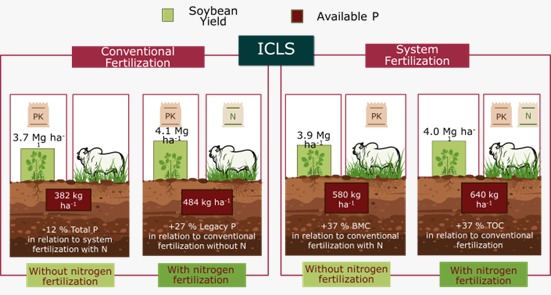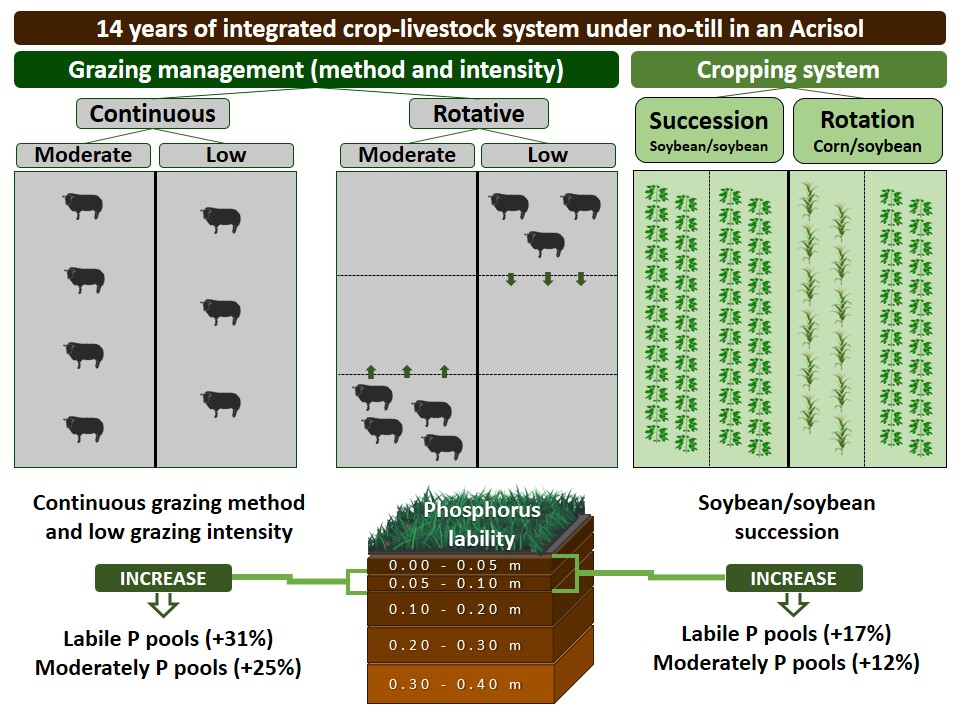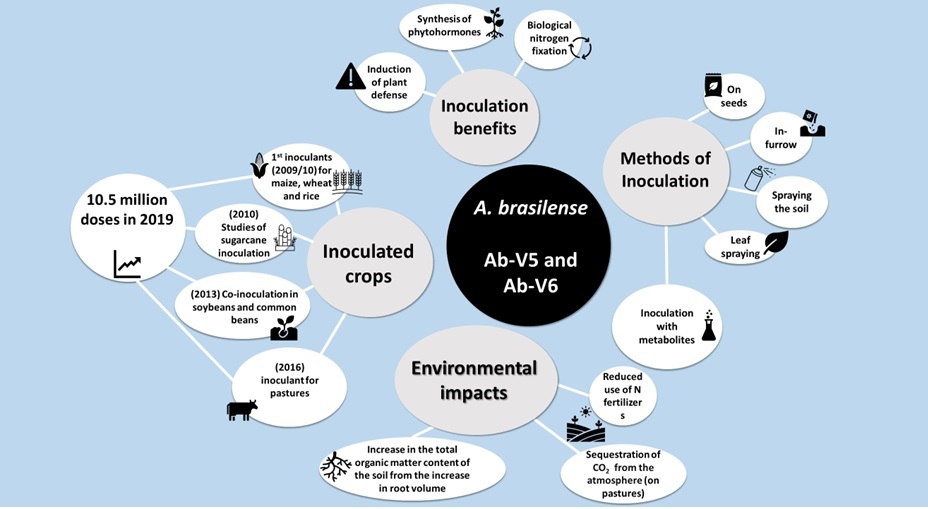Fertilization strategies to improve phosphorus availability and soil quality in integrated crop-livestock system in tropical soils
13/Oct/2025
ABSTRACT Exploring different fertilization strategies in an integrated crop-livestock system (ICLS) can enhance soil phosphorus (P) availability and improve soil quality, ultimately leading to higher yield. This study aimed to evaluate different fertilization strategies in ICLS and their effects on soil P fractions, soil quality and soybean grain yield in a tropical soil. Initiated in 2019, the experiment tested four fertilization strategies: 1) Conventional fertilization with P and K applied at soybean sowing (CF); 2) CF + N fertilization in […]
Phosphorus lability in a subtropical Acrisol under long-term integrated crop-livestock system: impacts of grazing management and cropping system
28/Oct/2022
ABSTRACT Studies on lability of soil phosphorus (P) under integrated crop-livestock systems (ICLS) are still scarce, especially for deep soil layers (more than 0.20 m depth) and different managements in the crop and livestock phase. Distinct management in these phases may lead to a different distribution of soil P pools according to its lability (labile, moderately labile, less labile and residual) and, consequently, the P availability for plant nutrition. This study aimed to determine the soil P pools, by P […]
Outstanding impact of Azospirillum brasilense strains Ab-V5 and Ab-V6 on the Brazilian agriculture: Lessons that farmers are receptive to adopt new microbial inoculants
24/Feb/2021
ABSTRACT For decades, researchers around the world search for strategies aiming at higher sustainability in agriculture. The microbial inoculants or biofertilizers are biotechnological products used for different purposes, the main one being to totally or partially replace chemical fertilizers, with an emphasis on N-fertilizers, reducing costs of production and decreasing the contamination of the soil, water, and atmosphere. Depending on the microorganism and the inoculated crop, inoculants can also induce plant protection to abiotic and biotic stresses and positively modify […]
Nitrogen Supply For Summer Crops Through Early Application In Ryegrass Grazed By Sheep
01/Sep/2015
ABSTRACT Greater nitrogen (N) cycling is sought through Integrated Crop-Livestock Systems (ICLS). The aim of this study was to evaluate the effect of early fertilization of nitrogen applied to ryegrass grazed by sheep on the nitrogen nutrition index (NNI) of summer crops in ICLS. This study was carried out in a long-term protocol managed in the winter under two stocking methods, continuous and rotational, and two grazing intensities, moderate and low, with four replications. In summer, the area was divided […]
Soil uses during the sugarcane fallow period: influence on soil chemical and physical properties and on sugarcane productivity
01/Apr/2014
The planting of diversified crops during the sugarcane fallow period can improve the chemical and physical properties and increase the production potential of the soil for the next sugarcane cycle. The primary purpose of this study was to assess the influence of various soil uses during the sugarcane fallow period on soil chemical and physical properties and productivity after the first sugarcane harvest. The experiment was conducted in two areas located in Jaboticabal, São Paulo State, Brazil (21o 14′ 05” […]
Soil uses in the sugarcane fallow period to improve chemical and physical properties of two latosols (oxisols)
01/Feb/2012
Sugarcane production should be integrated with crop diversification with a view to competitive and sustainable results in economic, social and environmental aspects. The purpose of this study was to assess the influence of different soil uses during the sugarcane fallow period on the chemical and physical properties of eutroferric Red Latosol – LVef (Oxisol) and Acric Latosol – LVw (Acric Oxisol), in Jaboticabal, São Paulo State, Brazil (21º14’05” S, 48º17’09” W, 600 m asl). A randomized block design was used […]
Available potassium in soils of southern Brazil estimated by multielement methods
01/Oct/2010
Potassium (K) availability to plants is estimated based on the exchangeable K fraction. Multielement methods increase the analysis efficiency in soil laboratories. The cation exchange capacity (CEC) of soils may affect the prediction of available K. Thus, the purpose of this study was to estimate the available K for corn and soybean in soils in the Rio Grande do Sul (RS) state using Mehlich-1 (M1), Mehlich-3 (M3), ion-exchange resin (resin), ammonium acetate pH 7.0 (AcNH4), and verify whether the CTC affects […]
Soil potassium content in an integrated crop-livestock system under no-tillage with different grazing intensities
01/Dec/2009
Potassium (K) dynamics in integrated crop-livestock (ICL) systems diverge from other tillage systems, because ICL systems are more complex and involve, apart from the cash crop management, the presence of animals. The objective of this study was to evaluate the soil K concentration in an ICL system under no-tillage with different grazing (black oat and Italian ryegrass) intensities in the winter growing season and soybean cultivated in the summer. The experiment was initiated in May 2001 on the Espinilho – […]
Soil organic carbon and nitrogen stocks in an untilled crop-livestock integration system under different grazing intensities
01/Dec/2009
The potential for adopting crop-livestock systems in southern Brazil is high, especially in untilled soybean areas with cover crops in the winter season. The long-term use of this system at different grazing intensities will result in different carbon and nitrogen stocks in the soil due to the different plant and animal residues. This research was conducted to evaluate alterations in total carbon and nitrogen pools and in organic matter fractions in a soil under different grazing intensities under no-tillage. The […]
Crop rotation under no-tillage in Tibagi (Paraná State, Brazil). II – CO2 and N2O emissions
01/Aug/2009
The agricultural activity can change the quantity and quality of soil organic matter (SOM), resulting in CO2 and N2O emissions from the soil. No-tillage (NT) with legume species in crop rotation is a strategy that should be considered not only to increase the SOM quantity, but also to reduce greenhouse gas emissions. The objective of this study was to determine the soil-atmosphere gas emissions with greenhouse effect (CO2 and N2O). For this purpose, an experiment was installed in Tibagi (Paraná […]



